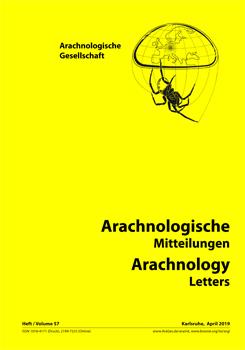A new species, Agyneta inermis spec. nov., is described, based on two males from Italy and Greece. The new species is very similar to the Iranian A. iranicaTanasevitch, 2011 (first record for Turkmenistan), but differs in structural details of the male palp, primarily by the absence of a tooth at the base of the embolus.
Examination of the extensive spider material collected by the Swiss arachnologist Antoine Senglet in Italy and Greece revealed a new species of Agyneta Hull, 1911 described here in the present paper.
Material and methods
This paper is based on material kept at the Muséum d'histoire naturelle de Genève, Switzerland (MHNG). Specimens preserved in 70% ethanol were studied using a MBS-9 stereomicroscope. The sequence of leg segment measurements is as follows: femur + patella + tibia + metatarsus + tarsus. All measurements are given in mm. The terminology of the copulatory organs mainly follows that of Merrett (1963) and Saaristo (1971, 1973).
Abbreviations used in the text and figures
E = embolus, EP = embolus proper (after Saaristo 1971), L = lamella characteristica, Mt = metatarsus, PH = pit hook (after Saaristo 1973), R = radix, T = tooth, TmI = position of metatarsal trichobothrium on leg I, ZMMU = Zoological Museum of the Moscow State University, Moscow, Russia.
Results
Taxonomy
Family Linyphiidae Blackwall, 1859
Subfamily Micronetinae Hull, 1920
Genus Agyneta Hull, 1911
Type species. Neriene subtilis O. Pickard-Cambridge, 1863, by original designation.
Agyneta inermis spec. nov. (Figs 1-10)
Material. Holotype: male (MHNG), ITALY, Calabria, Province of Cosenza, Tarsia, valley of Crati River (ca. 39.609°N, 16.273°E), 50 m a.s.l., 4.–5. Aug. 1968, leg. A. Senglet. Para-type: GREECE: 1 male (MHNG), Halkidiki, Nea Kallikratia (ca. 40.313°N, 23.063°E), 10 m a.s.l., 15. Jun. 1970, leg. A. Senglet.
Comparative material examined. Male holotype of Agyneta iranica Tanasevitch, 2011 (MHNG), IRAN, Golestan, between Naharkhoran and Gorgan (ca. 36.766°N, 54.471°E), 500–600 m a.s.l., forest, sifted litter and moss, 20. Jul. 1973, leg. A. Senglet. TURKMENISTAN, 1 male (ZMMU), Kopetdagh Mts, Firjuza (ca. 37.915°N, 58.089°E), 600–700 m a.s.l., 6.–17. Feb. 1979, leg. S. Kuznetsov. New record for the country.
Diagnosis. Agyneta inermis spec. nov. is very similar to A. iranica Tanasevitch, 2011, known from Iran (Tanasevitch 2011) and Turkmenistan (new data). The new species is distinguished by certain details of the structure of the lamella characteristica (Figs 7-10 vs. Fig. 11), by the shallow hollow on the apex of the palpal tibia (Fig. 3 vs. Fig. 13), as well as by the absence of a basal tooth at the base of the embolus (Fig. 6 vs. Fig. 12, tooth marked as “T”).
Etymology. The specific epithet is a Latin adjective meaning “unarmed”, referring to the absence of a tooth at the base of the embolus.
Description. Male (holotype). Total length 1.80. Prosoma 0.75 long, 0.55 wide, brown with dark margins. Chelicerae 0.33 long, weak. Legs pale brown. Leg I 3.07 long (0.80+0.23+0.78+0.73+0.53); IV 2.88 long (0.78+0.20+0.75+0.70+0.45). Opisthosoma 0.93 long, 0.60 wide, dark grey. Chaetotaxy: each tibia with two dorsal spines; Mt I–IV spineless. Metatarsus IV without a trichobothrium. TmI 0.31. Palp (Figs 1-10): tibia short, with a small, pointed, dorso-prolateral tubercle and a short, wide, keel-shaped, retrolateral outgrowth. Cymbium without posterodorsal apophysis. Paracymbium with well-developed pockets, except for apical one (see Saaristo 1973). Lamella characteristica a narrow band expanded at base, uncinate apically. Embolus without teeth at its base.
Female. Unknown.
Variation. As the palps in both type specimens seem to be identical, no variation in this structure has been found.
Distribution. The species is known from only two localities, one each in Italy and Greece.
Figs 1-13:
Palpal structure of Agyneta inermis sp. nov., holotype (1-10), and A. iranica Tanasevitch, 2011, holotype (11-13) after Tanasevitch (2011). 1. right palp, retrolateral view; 2. cymbium, prolateral view; 3-4, 13. palpal tibia, (3, 13) dorsal view, (4) dorso-prolateral view; 5. palpal tibia and paracymbium, retrolateral view; 6. embolus and lamella characteristica, ventral view; 7-11. lamella characteristica, different angles from ventro-retrolateral to dorsoretrolateral view, respectively, (10) and (11) nearly at the same position; 12. embolic division, ventral view. Scale bars: 0.1 mm

Acknowledgements
I am deeply grateful to Peter Schwendinger (MHNG) and Kirill Mikhailov (ZMMU) for the opportunity to work on the spider collections under their care, as well as to Sergei Golovatch (Moscow, Russia) for checking the English of an advanced draft. I also thank Nadine Dupérré (Hamburg, Germany) and Robert Bosmans (Gent, Belgium) who kindly reviewed the manuscript.





